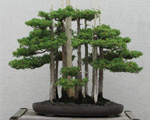Goshin is a bonsai created by John Y. Naka.

Goshin is a bonsai created by John Y. Naka. It is a forest of eleven junipers (Juniperus chinensis 'foemina'), the first of which Naka began working with bonsai in 1948. Naka donated his work at the National Bonsai Foundation in 1984, to be exhibited at the United States National Arboretum, and since then, there is exposed. Each tree represents one of the grandchildren of Naka.
Naka began working with the first two of the eleven trees that would eventually Goshin formed in 1948, he created a composition "two-trees" using two juniper trees of the same height. In 1953, he created Naka, during a demonstration for its school of bonsai, a juniper-style "formal upright." Later, he also bought a taller mast (destined to become the main shaft, the higher Goshin) , that has been transplanted in the ground and gradually worked and trained staff; was ready to be exhibited in 1960.
Goshin took the form of a forest for the first time to 1964.
Inspired by a forest of Cryptomeria japonica which is located near a shrine in Japan, Naka has put together first four trees that had already been used in another composition than 1.2 meters in height. He soon was joined by three others, to create a forest of seven bonsai. Naka also had to change the pot to improve drainage - the lack of which caused the death of one of the trees and its repeated replacements. At the moment, Naka had seven grandchildren, each of which was represented by a tree. At the instigation of fellow artists of bonsai, has given a name to its composition, has called "Goshin," which means "protector of the spirit", in reference to the name of the shrine which is located in the forest that inspired it. Since 1973, Naka had eleven grandchildren, and he ratcheted up eleven number of plants of Goshin.
After the donation, Naka returned frequently to Washington to inspect and supervise the maintenance of Goshin, including the remarkable work that was done in 1999. By that year, he created another bonsai forest is known as Goshin both. Naka died in 2004, his death a French website has posted the following: "John Naka is gone. A vague murmur of astonishment among the branches of Goshin."
